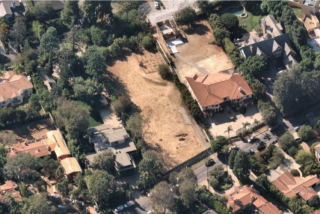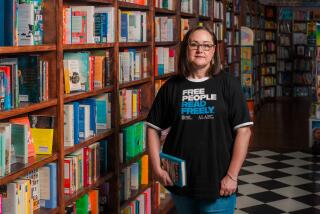Jane Jacobs, 89; Urban Theorist, Community Activist Who Fought Lower Manhattan Freeway Plan
Jane Jacobs, an urban theorist and community activist whose books argued for the rehabilitation of neighborhoods on traditional lines, breaking with emerging trends in city development, died Tuesday. She was 89.
An American-born citizen of Canada, Jacobs died at a hospital in Toronto of natural causes, according to publicist Sally Marvin of Random House, Jacobs’ publisher. Jacobs was admitted to the hospital late last week and had been in failing health for several years.
She was internationally known as an advocate of cities with distinct neighborhoods, built to a human scale, mixing commercial and residential space.
She was against building highways that cut through city centers and was once arrested at a public hearing after she stormed the podium to express her opposition to a plan for an expressway through lower Manhattan.
“Jane Jacobs’ thinking about cities was clear and it came from a person who lived in cities,” Toronto Mayor David Miller told The Times on Tuesday. “She didn’t just write about urban issues. She acted on her convictions.”
Jacobs’ most influential work, 1961’s “The Death and Life of Great American Cities,” set the stage for a battle that Jacobs waged for decades. Defying popular theories on how to renew city slums by plowing them under and replacing them with uniform housing projects, she pushed for recycled buildings and new structures scaled to the existing neighborhood.
Her feisty prose often read like a manifesto. “This book is an attack on current city planning and rebuilding,” she announced in the opening paragraph of “The Death and Life of Great American Cities.”
She continued: “It is also, and mostly, an attempt to introduce new principles of city planning and rebuilding, different and even opposite from those now taught in everything from schools of architecture and planning to Sunday supplements and women’s magazines.”
In her view a successful city needed vibrant neighborhoods linked by public transportation. Each area needed its own mix of old and new buildings, a constant influx of smaller, independent businesses, and a range of residential and commercial space.
Early critics accused her of being short on realistic solutions to the challenges of urban life. Admirers called her a maverick and a comprehensive thinker. Thirty years later, when her books were required reading in graduate school programs and many of her beliefs about cities were widely accepted, she was praised as a visionary and a pivotal figure in her field.
“It’s not that the world was one way before Jane Jacobs and changed 180 degrees because of her,” Paul Goldberger, architecture critic of the New Yorker magazine, said in an interview with the Los Angeles Times in 2003.
It was more a case of Jacobs daring to voice her complaints in a firm, public manner.
“Nobody else spoke out against the establishment the way Jacobs did,” Goldberger said. “In the ‘50s, American cities were generally considered messy, undesirable things. Suburban life was considered the ideal. Jane Jacobs fought valiantly in defense of plain, old-fashioned, urban life.”
She was opposed to the use of bulldozers as a tool for urban renewal. “From her point of view,” Goldberger said, “nothing was being renewed. It was all being destroyed.” Referring to Jacobs’ “The Death and Life of American Cities” as “arguably the most important book written about cities in the 20th century,” he summed up her attitude toward tear-down renewal: “The emperor of city planning has no clothes.”
As a writer and community activist, Jacobs’ energy was unrelenting. She challenged the views of influential thinkers such as historian Lewis Mumford, author of “The Culture of Cities.”
Her most audacious outburst came in the 1960s when New York City planner and power broker Robert Moses announced his plan for an expressway through the Washington Square area in lower Manhattan.
Jacobs attended the public hearing where she and other protesters vocally opposed the plan.
“He was one of the first speakers,” she recalled of Moses, in a 2000 interview with the Associated Press. “He was furious and he stood up there, inside the railed enclosure, and not where most speakers spoke -- outside where the public microphone was. He was privileged.
“He gripped this railing and he said, in dismissing scornfully our plan to have no more than the existing road and better not even that, he said, ‘These protests are just by a bunch of ... a bunch of mothers!’ ”
Jacobs, joined by other protesters, then rushed the podium, disrupting the meeting.
She was arrested on several charges, including criminal mischief, which established her as a terror, at least around City Hall. It also reduced to rubble any view that Jacobs was merely a disheveled, jolly-faced lady with the big, round glasses.
Rather, she was “a far-sighted genius who guided cities in new directions,” Robert Caro, who wrote a biography of Moses, told the Associated Press on Tuesday. Her battle with Moses was “one of the truly heroic sagas in the history of New York,” Caro said.
Jacobs first staked her claim as the bane of the establishment in 1961 when she led the opposition against a tear-down plan for her West Village neighborhood in lower Manhattan. Redevelopers intended to take out the brownstones and small apartment complexes in the area and replace them with a housing project that covered several blocks.
She argued against demolition and offered her own proposal, which preserved existing housing and added a middle-income apartment complex built to scale. Eventually, the plan she helped devise was approved.
“In the ‘60s, technocrats were leading the way in urban planning,” architect Eric Owen Moss told The Times in 2003.
His Los Angeles-based firm has recycled office space for housing and blended recycled buildings with new structures in the Jacobs tradition.
“Jacobs was a unique, sensitive voice for a different point of view,” Moss said. “The technocrat said, ‘We’ll put an expressway here, a dam there, a high-rise here’. She said, ‘Let’s not build the expressway through peoples’ backyards. Let’s keep the continuity of the existing neighborhood. And let’s have parks.’ ”
Forty years after she helped defeat plans for an expressway through lower Manhattan, Jacobs was still receiving phone calls from community activists across North America, seeking her guidance. In 2000, concerned citizens of Pittsburgh wanted to block a redevelopment project that would have wiped out two of the city’s downtown streets. Jacobs offered coaching by phone, and the Pittsburgh activists won their battle.
Her credentials for the role of urban strategist were comparatively sparse. Born May 4, 1916, in Scranton, Pa., she graduated from high school and worked briefly as a reporter on the Scranton Tribune before she moved to New York City. There she attended classes at Columbia University but did not complete her college degree.
She went to work as a freelance journalist covering urban issues. In 1952, she was hired by Architecture Forum magazine. She became a senior editor and remained on the staff until 1962. In her essay, “Downtown Is for People,” included in the book, “The Exploding Metropolis” (1958), Jacobs suggested ways to revitalize downtown areas.
She criticized governmental civic centers as “pretentious and dull” and said that shopping centers all look alike. The goal of urban renewal should be to make a city’s core, “more surprising, more compact, more variegated, and busier than ever,” she wrote.
Through the 1960s Jacobs was appointed to a series of government projects, including New York City Mayor John V. Lindsay’s Task Force on Housing and the Task Force on Natural Beauty, overseen by then-First Lady Lady Bird Johnson, that supported the planting of shrubs and flowers in public places.
She had gained both respect and notoriety in a male-dominated field, in a steeply competitive city. Then, somewhat abruptly, in 1968, Jacobs and her husband of 24 years, architect Robert Hyde Jacobs, moved their family of three children to Toronto.
The Jacobs, who had two sons close to draft age, opposed the Vietnam War. In 1974, Jane Jacobs became a Canadian citizen.
“Jane was part of a group of extremely articulate, independent thinking, highly accomplished people” who had a strong impact on the growth of the city, said Joe Berridge of Urban Strategies, a planning firm in Toronto. “By the early ‘70s, a few years after they settled in Toronto, it was taking off and becoming a great city.”
Within months of her arrival in Toronto, Jacobs imprinted her style when she joined a group of urban activists battling a proposed downtown expressway. The plan was ultimately defeated.
More recently, she fought a plan to build a bridge from downtown Toronto to the airport. “Storming the barricades with the help of her walker,” Berridge said of Jacobs’ style.
Urban planners in Toronto credit Jacobs with helping preserve the city’s highly livable neighborhoods and saving some of its worthy old buildings. Outspoken to the point of being brash, she once declared that the city planning board of Toronto was “brain-dead.”
“Jane Jacobs had a strong anti-bureaucratic bent,” said Eudora Pendergrast, who worked as a city planner for Toronto in the early ‘90s and more recently opened her own consulting firm. “That statement had an incredible effect. It shaped an effort by planners to be less bureaucratic. Jane Jacobs was highly respected.”
She continued to write books on her favorite topic. In “The Economy of Cities” (1969) and “Cities and the Wealth of Nations” (1984) she argued that the financial health of a nation depends on productive cities.
In one instance, she used Japan as an example. After World War II, a number of Japanese cities developed bicycle manufacturing factories that boosted the local economy. Business grew to the point where those cities were able to expand into automobile production. Within 30 years the Japanese economy went from one of the weakest to one of the strongest in the world.
Some critics challenged Jacobs for leaping too freely from the specific to the general. “She was on much firmer ground when she wrote about structure and form,” Goldberger said. “There, her theories bore out.”
When she was in her 80s and still living in the house she once shared with her husband and three children, journalists continued to called on her. Several of them made note of her eccentric taste in home decor.
Porch furniture in the living room, a closet converted to a telephone booth and a wooden model for a fighter plane fuel tank as a door stop were seen as proof of her commitment to recycling.
At age 88, she toured to promote her book, “Dark Age Ahead” (2004), taking questions with the help of an old-fashioned ear trumpet.
In the book she wrote that family and community bonds need reinforcing and that cities need a self-policing system to keep professionals in check.
To get to that point, her suggestion was to start small. “Everything is connected to everything else,” she wrote. “...if something is corrected and improved it’s likely to affect other things beneficially.”
Jacobs’ passion for cities never left her. “All through organized human history, if you wanted prosperity you had to have cities,” she told the Los Angeles Times in 1997, during a conference about her work held in Toronto. “Cities are places that attract new people with new ideas.”
Her husband died in 1996. She is survived by two sons, one daughter, two grandchildren, two great-grandchildren and a brother.
More to Read
Sign up for Essential California
The most important California stories and recommendations in your inbox every morning.
You may occasionally receive promotional content from the Los Angeles Times.










